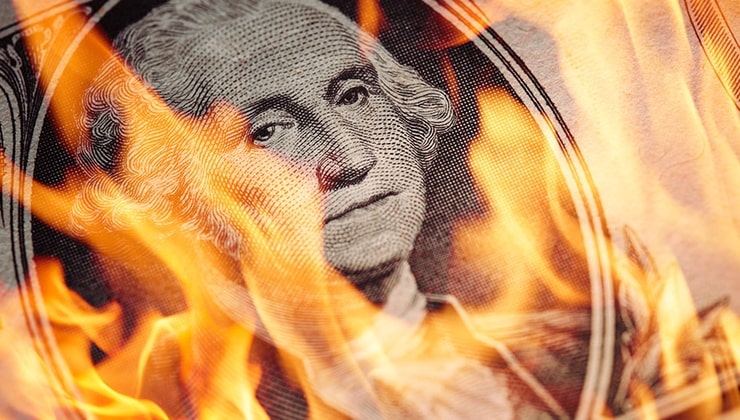Spread bets and CFDs are complex instruments and come with a high risk of losing money rapidly due to leverage. 73.7% of retail investor accounts lose money when trading spread bets and CFDs with this provider. You should consider whether you understand how spread bets and CFDs work, and whether you can afford to take the high risk of losing your money.
- English
- 中文版
Despite the easiest monetary policy the world has ever seen, inflation expectations have failed to pick up and the prospect of falling prices, or deflation, is now looming.
Remember how many times we feared recession last year?
There were many calls for concern: dampened global growth (especially eurozone and Japan), yield curve inversion, and mass debt overhangs from cheap credit binges - to name a few. The uninspiring backdrop was no help for inflation.
Inflation has been sluggish since the GFC and the economic backdrop isn’t encouraging. Once lockdowns ease, it could take years for consumption and economic activity to return to pre-pandemic levels. Even though global rates have reached near zero, inflation expectations have barely picked up. This has turned the conversation to deflation and the fear that falling prices could delay spending and exacerbate the downturn.
Policy response to falling prices
Central banks across the world are mandated to meet inflation targets. As we stagger out of this crisis, prices will fall and the result will be interest rates stuck at the effective lower bound for a long time until policymakers can see a path towards inflation targets.
US inflation expectations have been falling since 2018, and have fluctuated around 1.5% since April. This is below the Fed’s target of 2% but considerably up from the March low.
US 5-yr, 5-yr forward inflation expectations (%). Inflation expectations were modestly falling throughout 2019 until a sharp decline in March 2020. Expectations have rebounded and fluctuated around 1.5% since. Chart source data: St Louis Fed.
This is the Fed’s inflation expectation model: their long run inflation target is 2% and policy will be adjusted to meet this mandate and promote full employment. But not even the easiest monetary conditions have so far meaningfully lifted expectations, so what more can the Fed do? Fed Chair Jerome Powell has signalled he thinks negative rates are inappropriate, however this week markets began pricing in the possibility of a negative Fed funds rate for 2021.
Australia
The Reserve Bank of Australia (RBA) addressed the prospect of falling prices at its May meeting. The bank noted that although CPI increased 2.2% YoY in Q1, Q2 CPI is expected to print negative in June, mostly due to tumbling oil prices and the introduction of free childcare. The RBA sees inflation rising to 1% - 1.5% in 2021 before slowly rising from there. It’s a long time before inflation rises to the 2% - 2% target. So low rates are here for the long-run.
USD king in deflationary world
The US dollar will win if inflation expectations really start to roll over. Falling prices will hurt a lot of currencies, the lower inflation the weaker a currency will be. It will particularly hit risk currencies like CAD, AUD, and NZD, and would cause more pain for an already weak euro. But as is often the case, the USD is an exception.
US Treasuries are arguably the most liquid market in the world, and these will look more appealing if inflation expectations fall and the real yield rises.
The real yield on US Treasuries is the nominal interest rate less inflation expectations. Diminishing inflation expectations and the real yield rises. A higher yield increases demand and investors will need USD cash to invest, so the USD appreciates.
Real rates on longer duration treasuries have been moving deeper negative this year. With the Fed purchasing mass amounts of US government debt in QE unlimited, the nominal rate is in no rush to rise. Since early April, 5-yr through 30-yr treasuries have traded with negative real yields. If deflation tips these positive, we could see another rush to the USD.
Gold and other safe havens
Gold is the ultimate hedge against a poor economic backdrop so works well in a downturn, meanwhile monetary easing measures make the case for gold as bullish as ever. But if inflation expectations roll over, real expected returns will rise and I would expect gold to sell-off as investors reallocate capital.
Safe havens like JPY and CHF could outperform in such an uncertain environment, however it would be best to remove the USD from the equation as it would likely appreciate in a deflationary environment. Consider the safe havens against an underperforming currency like the euro. Downside on EURJPY and EURCHF might better capture a safe haven flight.
Inflation on the horizon?
While deflationary forces dominate the short-term outlook, we need to consider relative growth in 2021. This year, data for Q2 and Q3 will be among the worst in history as lockdowns stall economic activity followed by a dragging recovery.
Growth is relative, so growth figures could be huge next year when compared to the same quarter prior year, even if economic activity remains below pre-pandemic levels. This could be a boost to inflation, and something we will be watching closely.
Related articles
Ready to trade?
It's quick and easy to get started. Apply in minutes with our simple application process.
The material provided here has not been prepared in accordance with legal requirements designed to promote the independence of investment research and as such is considered to be a marketing communication. Whilst it is not subject to any prohibition on dealing ahead of the dissemination of investment research we will not seek to take any advantage before providing it to our clients.
Pepperstone doesn’t represent that the material provided here is accurate, current or complete, and therefore shouldn’t be relied upon as such. The information, whether from a third party or not, isn’t to be considered as a recommendation; or an offer to buy or sell; or the solicitation of an offer to buy or sell any security, financial product or instrument; or to participate in any particular trading strategy. It does not take into account readers’ financial situation or investment objectives. We advise any readers of this content to seek their own advice. Without the approval of Pepperstone, reproduction or redistribution of this information isn’t permitted..



